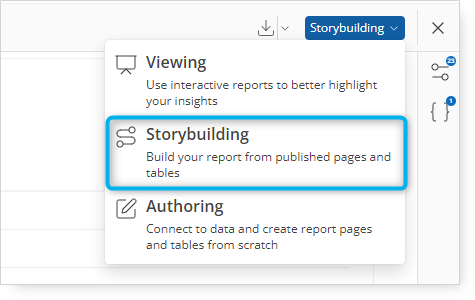Storybuilding - General Remarks
Storybuilding is a reporting mode that can be considered an intermediate step between Viewing (which does not offer any ability to edit the underlying report) and Authoring (which allows creation of pages and reports from scratch). Ideally suited to Viewer users, the Storybuilding mode provides a powerful extension to the Viewing mode, allowing Viewer users to leverage content to which they have been granted access, to build their own reports. This can involve merging content from multiple reports, adding, removing or reordering pages, changing the report theme and applying appropriate parameters, before then saving and sharing these reports with other users. Authoring users are also provided access to the Storybuilding mode. For authors, Storybuilding simply provides an alternative way to edit existing reports, or to create new reports by merging elements from existing content.

From an interface perspective, the Storybuilding mode is extending the Viewing interface with additional capabilities related to the modification of the report structure.
Users need to have the Storybuilder role to be able to access the Storybuilding mode. Without this role, it is only possible to use the Viewing mode while browsing any report.
Each user with access to the Authoring tools gets access to the Storybuilding mode and can use both modes to edit the reports.
Storybuilders can create new reports on Halo but are limited to reusing the pages of existing reports that they have access to and the rights to reuse. Without access to the Authoring tools as well, they cannot switch to the Authoring mode to preview existing definitions or build new pages.
For the reports that they have Edit access to (either their own or shared with them with Edit rights), Storybuilders can modify the reports within the boundaries of the actions enabled by the Storybuilding interface, i.e., they can add, remove, or reorder pages within the report, as well as influence the state of those pages within the limits enabled by their authors (e.g., changing parameters or page settings). Editing the report in Storybuilding is done on top of the report that has been opened, so the Save action will overwrite the report with any changes made. An additional disclaimer is in place to ensure users do not unintentionally overwrite the report.
For the reports to which they have view access, they cannot overwrite the report, but if the document allows this, they can use it as a starting point for their reporting e.g., by creating their editable copy of that report, or by merging content of that report into their report.
It is important to remember that in the current version of our system, any user that opens a report should be separately granted access to the datasets used by this report, otherwise, the content of the report will not be displayed correctly.
Storybuilding does not influence the general logic of working with the reports in Halo - any report is always opened as a temporary working copy based on the last saved version of the document. This implies that any changes made within the document will not be preserved unless the report is explicitly saved in a new state.
It is important to understand that all reporting modes work with the same document underneath, only providing different interface options. As a consequence, any changes made while working in Storybuilding will be reflected in the Viewing and Authoring modes as well. For example, if we remove some pages and switch to the Authoring mode, we will also see those pages removed when looking at the Compose module.
While any changes in the report are synced between all modes, it is important to remember that only the Storybuilding and Authoring modes allow saving the changes (by overwriting the report or making a new copy). Storybuilders can switch to Viewing mode, but in order to save any changes made, they will need to go back to the Storybuilding mode.